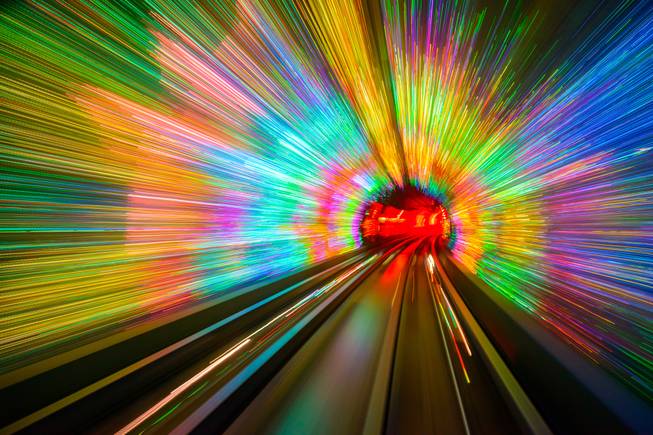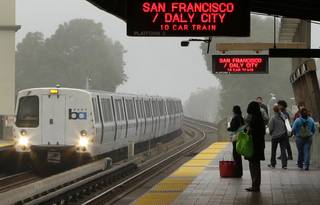
Shutterstock.com
Monday, Jan. 18, 2016 | 2 a.m.
Related Content
- How does Southern Nevada pay for a new mass transit system?
- Light rail: The future of transportation in Las Vegas?
- How does a plan like this come to be? Who is responsible
- Rail projects in other cities: How’d they do it?
- Getting Southern Nevada’s future on the right track
- How mass transit will affect Southern Nevada business
- How mass transit will affect Southern Nevada tourism
- How mass transit will affect Southern Nevada tourism
- How mass transit will affect downtown Las Vegas
- How mass transit will affect North Las Vegas
- How mass transit will affect sports in Southern Nevada
- How mass transit will affect Southern Nevada’s people and lifestyle
- A local’s take: The evolution of transportation in Las Vegas
- Editorial: Why Southern Nevada needs mass transit
- The Sun's light rail coverage
There’s a problem with our transportation system, Las Vegas, and it goes way beyond tedious commutes and long lines of orange pylons.
The system has become an Achilles heel in a high-stakes competition with other major cities to attract new businesses, residents, tourists and conventions. Our road system is outdated, built for an era of rotary phones, coin slot machines and cars with cassette players, and other communities are taking advantage of it in an attempt to leapfrog us.
Don’t believe it? Let’s take a trip to Orlando, Fla.
There, a commuter train whisks passengers along a 31-mile route that connects downtown Orlando with suburbs and surrounding communities for as little as $3.75 per round trip. Transportation authorities recently approved a new phase of development that will connect the system, called SunRail, with Orlando International Airport.
When that happens, look out. Visitors will be able to jump on the system for a quick, cheap and convenient ride to hotels, attractions and convention halls, while their counterparts in Las Vegas endure long lines for taxis or Uber and Lyft vehicles, then face expensive, slow rides on congested streets and highways, where, of course, they have to suffer more expensive, slow rides if they want to go anywhere beyond walking distance.
Which sounds better? It’s no contest.
Don’t think Orlando isn’t trying to capitalize on its advantage either. During a recent visit there, a Las Vegan found a list of our conventions written on a white board at the convention and visitors bureau. True story. Scary story.
And Orlando isn’t the only city actively trying to pick off our conventions.
Meanwhile, the Strip has reached a tipping point on traffic congestion, and that’s without attractions that either are on the drawing board or are almost live. T-Mobile Arena between New York-New York and Monte Carlo is an example; as many as 20,000 people will be trying to get in and out of events there once it opens. Because Las Vegas always has been a place that looks for the next big thing, others are talking about equally ambitious plans for facilities that will, inevitably, place further strain on our transportation system.
Another source of pressure: With traffic at McCarran International Airport reaching its pre-recession levels, the city moves an average of 1.8 million people per month — and counting — between the Strip and the airport.
Given that tourism and convention tax revenue and fees are the leading economic drivers for the state, it’s critical that the Las Vegas transportation system supports them. But there is more reason to consider upgrades: The tech industry sector that now is taking a close look at Las Vegas, and Nevada expects — and a new workforce demands — effective and convenient mass transportation options.
Put simply: Our infrastructure isn’t prepared to support the next generation of development in Las Vegas.
But here’s the good news. We can compete in this fight. The answer is to build our own light rail — either the system proposed by the Regional Transportation Commission of Southern Nevada or one that extends the RTC’s lines to North Las Vegas.
42.3 million
Number of annual tourists to Las Vegas, and each tourist visits an average of 6.4 casinos.
That’s more than 5.2 million trips along the crowded resort corridor each week.
That doesn’t include the 658,000 trips tourists make to McCarran International Airport each week.
Or the 100,000 Strip workers who, if they work five days a week, make another 1 million trips each week to and from the Strip.
All together, the Strip sees at least 6.8 million trips per week.
When put in those terms, the sheer scale of the challenge to create a light rail system and the opportunity it could present become readily apparent.
Reader poll
Make no mistake, the system would be costly. The RTC’s plan, which connects McCarran International Airport to downtown’s Bonneville Transit Center and then to Cashman Center, would cost a minimum of $600 million and as much as $5.7 billion (if portions are built underground) in today’s dollars.
The RTC has proposed paying for a significant portion of the system through federal funding and has floated the concept of a public-private partnership. A rider fee also is part of the RTC’s vision. In addition, there are other potential options for revenue streams that would lessen the burden on Las Vegas residents, such as an increase in hotel room tax, higher surcharges on flights from McCarran and perhaps reclaiming and selling BLM land on the outskirts of Las Vegas. Steps like these might make it possible to both build the system and let tourists and locals ride it for free.
The 42.3 million visitors coming to Las Vegas annually — a figure that is expected to keep rising — could foot the bill for a portion of the system. Even with a modest increase in fees to support a rail system, tourists come out ahead because they wouldn’t have to pay as much for taxi rides or rental cars.
Now, think about what the system would mean for Las Vegas residents. It would allow tens of thousands of people get to work more easily and cheaply, not only the ones riding the light rail, but car commuters who’d benefit from a reduction of congestion on the roads. It would ease the pressure on our environment. It would create jobs and spur massive development of housing, retail and industry — with an economic impact of $56 billion to $178 billion, as estimated by the RTC.
If you doubt the potential of light rail as an economic driver, just look at Phoenix, Salt Lake City and Denver — other Western communities that have invested in rail systems. Development driven by light rail in Phoenix exceeded $8.2 billion this year, including 15,000 residential units within a half mile of the 20-mile route. The 7-year-old system is being used for 44,000 rides per average weekday, more than the Phoenix transit authority estimated for ridership in 2020.
For Las Vegas, light rail would create new development opportunities and strengthen the heart of our economy by improving the Strip. Tourists like trains — just ask the operators of San Francisco’s cable cars or New Orleans’ streetcars — and light rail would make getting up and down Las Vegas Boulevard a convenient attraction for visitors, not a bumper-to-bumper buzzkill.
Improving the visitor experience is critical to our future. Remember, the days are long gone when Las Vegas tourists checked into a resort, headed straight to the casino and holed up for as long as their bankroll held out. Today, the average tourist visits several casinos per visit, and a change in the Strip’s business model is prompting even more of them to get out and wander among a growing number of restaurants, shops and attractions.
Allowing visitors to get around more easily is key to keeping them happy. And just imagine how happy they’d be if they could cruise the boulevard in a train that allowed them to see the sights and quickly reach their destination. Lights, action, fabulousness.
Even beyond the Strip, light rail is a link to our economic future. It would help attract and retain the millennial workers we need for our budding technology industry and other businesses that can diversify our economy. If you don’t think light rail is a major bargaining chip when trying to recruit younger workers, just look at any number of studies showing that millennials are waiting later to get driver’s licenses than other generations, are less likely to use cars as a main source of transportation and are more likely to walk, bike or use public transit.
Another sector that could take off: manufacturing. For the first time, North Las Vegas could gain a direct connection to the Strip, which would help in the development of the massive Apex Industrial Park. With Faraday Future preparing to build a $1 billion car manufacturing plant there, a rail link would become an attractive incentive to help sell other companies on locating in Apex.
Then there’s the north Strip. Today — and this isn’t a big secret — it’s struggling. SLS Las Vegas has been bleeding revenue since it opened. The closure of the Riviera opened an even bigger hole between the Wynn and Encore, and the SLS and Stratosphere. And while the Lucky Dragon project west of Las Vegas Boulevard on Sahara Avenue may inject some energy into the area, there’s nothing else being developed between Resorts World Las Vegas and downtown. Plus, the Genting Group has yet to begin construction in earnest, raising concerns the project may not be moving forward.
In that environment, a light rail could be a lifesaver. For most Strip tourists, the Riviera/Fountainebleu area marks a no-man’s-land where they quit walking on the boulevard, feeling ill at ease among the rusting hulk of empty and abandoned resorts. Add a train, and getting to the SLS, Stratosphere and beyond is safe and fun.
For downtown, the rail would bring tourists and locals not only to East Fremont and the Fremont Street Experience but to the Arts District and the Smith Center for the Performing Arts. Light rail lines would become arteries to invigorate arts and culture.
There also are winners who would never even set foot on the train. They’d benefit because the system would provide the tool to compete with cities such as Orlando for tourists, conventions and economic development, therefore strengthening the economy valleywide.
The harsh reality, Las Vegas, is that we risk getting stuck in gear economically if we don’t do something about our transportation system. Right now, nothing is happening to create more area for development on the Strip. We still rely mostly on tourism and mining as the underpinnings of our economy, leaving us vulnerable to the same busts we just went through during the recession.
And while tourists still are coming, other cities are fighting to siphon them away. Granted, Orlando is no Las Vegas when it comes to 24/7 fun, but it is positioning itself as a modern, progressive, convenient option other than Las Vegas.
Las Vegas has explored light rail before, only to set it aside while others pushed forward. Now we’re behind, and we have a major choice on our hands. Move in a new direction, or stay on the same path. Just watch out for the orange pylons.
Editor’s note: This story was revised to clarify that Orlando’s SunRail is a commuter train, and that officials have approved a new phase of development that would connect it to the airport.


Join the Discussion:
Check this out for a full explanation of our conversion to the LiveFyre commenting system and instructions on how to sign up for an account.
Full comments policy